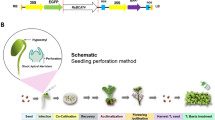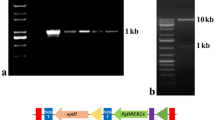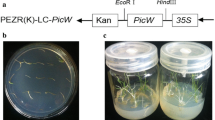Abstract
An Arabidopsis β-glucosidase, AtBG1 is known to hydrolyze glucose-conjugated, biologically inactive abscisic acid (ABA) to produce active ABA, which increases the level of ABA in plants. Since an increase of ABA in plants confers tolerance against abiotic stress such as drought, we introduced the pCAMBIA3301 vector harboring the AtBG1 gene into creeping bentgrass through Agrobacterium-mediated transformation. After transformation, putative transgenic plants were selected using the BASTA resistance assay at a concentration of 0.8 %. Genomic integration of the AtBG1 gene was confirmed by genomic PCR and Southern blot analysis, and gene expression was validated by Northern blot and Western blot analyses. Interestingly, the transgenic bentgrass plants overexpressing AtBG1 had a dwarf phenotype with reduced growth rates when compared to wild-type creeping bentgrass. In addition, the transgenic plants accumulated higher ABA levels and displayed enhanced drought tolerance. These results suggest that the expression of AtBG1 in plants induces the accumulation of higher ABA levels, which results in the formation of dwarf creeping bentgrass and enhances the survival in water-limiting environments.
Key message We used an Arabidopsis β-glucosidase AtBG1 to engineer a crop with elevated active ABA levels, and developed transgenic creeping bentgrass with enhanced drought tolerance and dwarf phenotype.






Similar content being viewed by others
References
Aswath CR, Kim SH, Mo SY, Kim DH (2005) Transgenic plants of creeping bent grass harboring the stress inducible gene, 9-cis-epoxycarotenoid dioxygenase, are highly tolerant to drought and NaCl stress. Plant Growth Regul 47:129–139
Bajji M, Lutts S, Kinet JM (2000) Physiological changes after exposure to and recovery from polyethylene glycol-induced water deficit in roots and leaves of durum wheat (Triticum curum Desf.) cultivars differing in drought tolerance. J Plant Physiol 157:100–108
Chen H, Nelson RS, Sherwood JL (1994) Enhanced recovery of transformants of Agrobacterium tumefaciens after freeze-thaw transformation and drug selection. Biotechniques 16:664–670
Cho KC, Han YJ, Kim SJ, Lee SS, Hwang OJ, Song PS, Kim YS, Kim JI (2011) Resistance to Rhizoctonia solani AG-2-2 (IIIB) in creeping bentgrass plants transformed with pepper esterase gene PepEST. Plant Pathol 60:631–639
Han YJ, Kim YM, Lee JY, Kim SJ, Cho KC, Chandrasekhar T, Song PS, Woo YM, Kim JI (2009) Production of purple-colored creeping bentgrass using maize transcription factor genes Pl and Lc through Agrobacterium-mediated transformation. Plant Cell Rep 28:397–406
Iuchi S, Kobayashi M, Taji T, Naramoto M, Seki M, Kato T, Tabata S, Kakubari Y, Yamaguchi-Shinozaki K, Shinozaki K (2001) Regulation of drought tolerance by gene manipulation of 9-cis-epoxycarotenoid dioxygenase, a key enzyme in abscisic acid biosynthesis in Arabidopsis. Plant J 27:325–333
Kim SJ, Lee JY, Kim YM, Yang SS, Hwang OJ, Hong NJ, Kim KM, Lee HY, Song PS, Kim JI (2007) Agrobacterium-mediated high-efficiency transformation of creeping bentgrass with herbicide resistance. J Plant Biol 50:577–585
Lee KH, Piao HL, Kim HY, Choi SM, Jiang F, Hartung W, Hwang I, Kwak JM, Lee IJ, Hwang I (2006) Activation of glucosidase via stress-induced polymerization rapidly increases active pools of abscisic acid. Cell 126:1109–1120
Luo H, Hu Q, Nelson K, Longo C, Kausch AP, Chandlee JM, Wipff JK, Fricker CR (2004) Agrobacterium tumefaciens-mediated creeping bentgrass (Agrostis stolonifera L.) transformation using phosphinothricin selection results in a high frequency of single-copy transgene integration. Plant Cell Rep 22:645–652
Nambara E, Marion-Poll A (2005) Abscisic acid biosynthesis and catabolism. Annu Rev Plant Biol 56:165–185
Park HY, Seok HY, Park BK, Kim SH, Goh CH, Lee BH, Lee CH, Moon YH (2008) Overexpression of Arabidopsis ZEP enhances tolerance to osmotic stress. Biochem Biophys Res Commun 375:80–85
Priest DM, Ambrose SJ, Vaistij FE, Elias L, Higgins GS, Ross AR, Abrams SR, Bowles DJ (2006) Use of the glucosyltransferase UGT71B6 to disturb abscisic acid homeostasis in Arabidopsis thaliana. Plant J 46:492–502
Qin X, Zeevaart JA (2002) Overexpression of a 9-cis-epoxycarotenoid dioxygenase gene in Nicotiana plumbaginifolia increases abscisic acid and phaseic acid levels and enhances drought tolerance. Plant Physiol 128:544–551
Ren H, Gao Z, Chen L, Wei K, Liu J, Fan Y, Davies WJ, Jia W, Zhang J (2007) Dynamic analysis of ABA accumulation in relation to the rate of ABA catabolism in maize tissues under water deficit. J Exp Bot 58:211–219
Sauter A, Dietz KJ, Hartung W (2002) A possible stress physiological role of abscisic acid conjugates in root-to-shoot signalling. Plant, Cell Environ 25:223–228
Schroeder JI, Nambara E (2006) A quick release mechanism for abscisic acid. Cell 126:1023–1025
Taylor IB, Sonneveld T, Bugg TDH, Thomson AJ (2005) Regulation and manipulation of the biosynthesis of abscisic acid, including the supply of xanthophyll precursors. J Plant Growth Regul 24:253–273
Thompson AJ, Jackson AC, Symonds RC, Mulholland BJ, Dadswell AR, Blake PS, Burbidge A, Taylor IB (2000) Ectopic expression of a tomato 9-cis-epoxycarotenoid dioxygenase gene causes over-production of abscisic acid. Plant J 23:363–374
Thompson AJ, Andrews J, Mulholland BJ, McKee JM, Hilton HW, Horridge JS, Farquhar GD, Smeeton RC, Smillie IR, Black CR, Taylor IB (2007) Overproduction of abscisic acid in tomato increases transpiration efficiency and root hydraulic conductivity and influences leaf expansion. Plant Physiol 143:1905–1917
Tung SA, Smeeton R, White CA, Black CR, Taylor IB, Hilton HW, Thompson AJ (2008) Over-expression of LeNCED1 in tomato (Solanum lycopersicum L.) with the rbcS3C promoter allows recovery of lines that accumulate very high levels of abscisic acid and exhibit severe phenotypes. Plant, Cell Environ 31:968–981
Verslues PE, Zhu JK (2007) New developments in abscisic acid perception and metabolism. Curr Opin Plant Biol 10:447–452
Warnke S (2003) Creeping bentgrass (Agrostis stolonifera L.). In: Casler DD, Duncan RR (eds) Turfgrass biology, genetics, and breeding. Wiley, New Jersey, pp 175–185
Xiong L, Zhu JK (2003) Regulation of abscisic acid biosynthesis. Plant Physiol 133:29–36
Yu TT, Skinner DZ, Liang GH, Trick HN, Huang B, Muthukrishnan S (2000) Agrobacterium-mediated transformation of creeping bentgrass using GFP as a reporter gene. Hereditas 133:229–233
Zhong H, Boyland MG, Srinivasan C, Sticklen MB (1993) Transgenic plants of turfgrass (Agrostis palustris Huds.) from microprojectile bombardment of embryogenic callus. Plant Cell Rep 13:1–6
Zilinskas BA, Wang X (2004) Genetic transformation of turfgrass. In: Liang GH, Skinner DZ (eds) Genetically modified crops: their development, uses, and risks. Food Product Press, New York, pp 309–350
Acknowledgments
The authors thank the Kumho Life Science Laboratory in Chonnam National University for providing plant growth facilities. This work was supported by Next-Generation BioGreen 21 Program, Rural Development Administration, Republic of Korea (PJ007978042011), and by Technology Development Program for Agriculture and Forestry, Ministry for Agriculture, Forestry and Fisheries, Republic of Korea (Grant # 309017-5).
Author information
Authors and Affiliations
Corresponding author
Additional information
Communicated by J. R. Liu.
Electronic supplementary material
Below is the link to the electronic supplementary material.
Rights and permissions
About this article
Cite this article
Han, YJ., Cho, KC., Hwang, OJ. et al. Overexpression of an Arabidopsis β-glucosidase gene enhances drought resistance with dwarf phenotype in creeping bentgrass. Plant Cell Rep 31, 1677–1686 (2012). https://doi.org/10.1007/s00299-012-1280-6
Received:
Revised:
Accepted:
Published:
Issue Date:
DOI: https://doi.org/10.1007/s00299-012-1280-6




